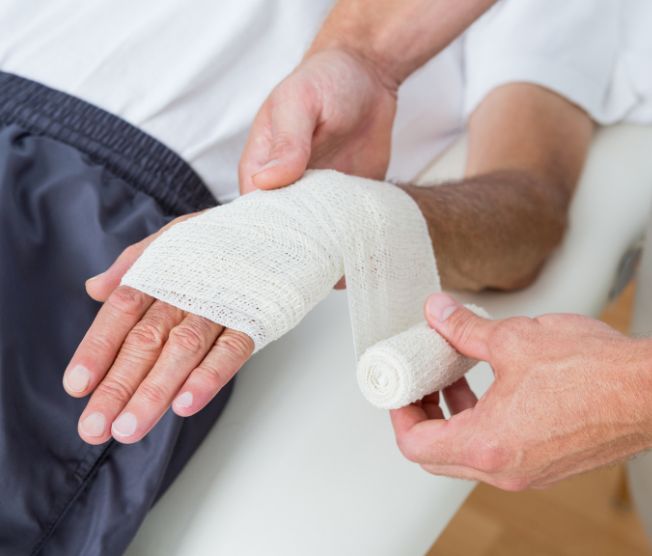 A burn is defined as tissue damage caused by exposure to heat, chemicals, radiation or electricity. Burn severity ranges from superficial to serious, affecting deeper layers of skin and causing life-threatening injuries.
A burn is defined as tissue damage caused by exposure to heat, chemicals, radiation or electricity. Burn severity ranges from superficial to serious, affecting deeper layers of skin and causing life-threatening injuries.
While people of all ages can experience burn injuries, older adults are particularly vulnerable and experience longer healing times due to age-related skin and muscle changes. Whether for yourself or a loved one, be aware of the following factors.
What Is a Burn Injury?
Common sources of burns include hot liquids, fire, using the stove, contact with steam, the sun, exposure to acids, and splashes with drain cleaner and other household chemicals.
Burn depth and severity can vary. First-degree burns affect the top layer of skin and heal on their own, while second-degree burns involve the outer and middle layers of skin, often causing blistering and pain.
Third-degree burns cover a larger portion of the body, affect the fat below the skin and require medical treatment. Even if a person recovers from a third-degree burn, permanent nerve damage and scarring can result.
Older adults have higher risks for accidental burns. This injury often stems from cooking, getting a sunburn or incorrectly lighting a fire. Failing to address a burn right away, especially a second or third-degree injury, may lead to complications like:
- A bacterial infection or sepsis
- Declining blood volume
- Hypothermia
- Breathing issues
- Keloid scarring
- Contractures around the joints
- Arrhythmia
- Dehydration
- Edema
- Pneumonia
- Organ failure
- Low blood pressure leading to shock
Specific Concerns for Older Adults
Older adults are more vulnerable to burns and have a higher likelihood of complications during recovery.
A study from the National Burn Repository of the American Burn Association found that older adults account for about 10 percent of all burn unit admissions, with the average patient being 76 years old. Women appear more susceptible than men to burn injuries. Other highlights from the study include:
- Cooking and using a stove are the main sources of burn injuries among older adults, including exposure to flames, touching hot surfaces and scalding.
- Declining mobility and reactivity increase a senior’s burn injury risk and its severity. Specifically, older adults are more susceptible to deep-partial and full-thickness burns. Other factors increasing wound severity include declining skin sensitivity, muscle atrophy, impaired vision, decreasing coordination and medication side effects.
- Adults 60 and older see higher hospitalization and fatality rates from burn injuries.
- Recovery also takes longer for older people due to thinning skin, limited nutrition, metabolic changes and an altered inflammatory response. Older adults further risk developing pulmonary edema, congestive heart failure and pneumonia in recovery.
When to See a Doctor
While running the burn under cold water may help, the injury requires medical attention if:
- The burn covers most of your hands, face, feet or groin, one or more joints or another large area of your body
- The burn has a leathery appearance, a sign the injury has affected deeper tissue, or is black, brown or white in color
- The burn is from chemical or electrical exposure
- The burn affected an airway or you have difficulty breathing
- The injury causes you pain
- You see redness, oozing fluid or swelling around the burn
- You develop blisters that don’t heal
- Your skin starts to scar
When seeking treatment:
- Treat your burn at home before seeking medical attention. Run the burned area under cool water, apply aloe vera once it has cooled and protect the area with a bandage. In the meantime, avoid popping any blisters and take a pain reliever.
- A doctor will assess the severity of the injury. For burns affecting 10 percent or more of the body, on an area like your face or feet, or affecting the tissue below the skin, you may be directed to a burn unit for further treatment. Also expect to undergo bloodwork and imaging to have the full extent of your injuries assessed.
- If the burn is superficial, you may be told to continue treating it at home.
- For more severe injuries, your doctor may recommend a regimen of medications, wound dressing, therapy, hydration, greater protein intake and pain management to minimize infection and scarring risks.
- Skin grafts and surgery may be needed for more severe injuries. Also expect to undergo a few months of short-term rehabilitation, especially if the burn occurred near or involved one or more joints. During rehabilitation, physical therapy helps to stretch the skin and improve flexibility, muscle strength and coordination. Occupational therapy is often prescribed to help you re-learn or adapt to daily tasks.
Reducing Risks for Burns in Older Adults
To lessen the risks for burn injuries:
- Always use mitts when cooking on the stove
- Do not use a heating pad directly on the skin
- Be ready to stop, drop and roll if your clothing catches on fire
- Keep a towel nearby to extinguish any flames
- Put on sunscreen before going outdoors and wear a hat
- Never ignore a minor burn
- In most cases, prepare to seek medical attention for your burn injury
While recovering from a burn injury, complete your short-term recovery plan at West Hartford Health & Rehabilitation Center. Contact us to learn more.
« Types & Causes of Chronic Wounds

